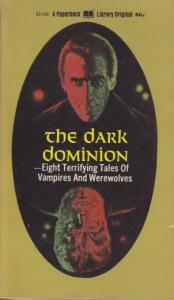 One of the oldest tricks in the capitalistic playbook is to make something look like a more successful product.Trademarks and copyright laws prevent too close a similarity—for money is sacred—but we all know “brands” that try to look like other brands in hopes of picking up some of the business that attends success.The same feature was apparently at operation behind The Dark Dominion: Eight Terrifying Tales of Vampires and Werewolves.This is a book that I picked up in a used bookstore because its cover design—a dull olive green with a picture oval on the front—was clearly based on the Dark Shadows book series.While the latter are still available, they’re increasingly difficult to find in used bookstores, so when I come across one I don’t have I tend to buy it.I knew this wasn’t part of the series but the cover suggested to me it might be similar enough, like store-brand breakfast cereal.
One of the oldest tricks in the capitalistic playbook is to make something look like a more successful product.Trademarks and copyright laws prevent too close a similarity—for money is sacred—but we all know “brands” that try to look like other brands in hopes of picking up some of the business that attends success.The same feature was apparently at operation behind The Dark Dominion: Eight Terrifying Tales of Vampires and Werewolves.This is a book that I picked up in a used bookstore because its cover design—a dull olive green with a picture oval on the front—was clearly based on the Dark Shadows book series.While the latter are still available, they’re increasingly difficult to find in used bookstores, so when I come across one I don’t have I tend to buy it.I knew this wasn’t part of the series but the cover suggested to me it might be similar enough, like store-brand breakfast cereal.
Werewolf stories, it turns out, shouldn’t hunt in packs.There’s no surprise since it’s pretty clear that one of the characters is a shapeshifter and it’s pretty obvious which one.Six, or maybe seven, of the eight stories concern werewolves while one outlier has a vampire menace.Some of the stories in the book are clever, but most follow the same trajectory: attacks are made, the villagers suspect something, one of them turns out to be a werewolf.Time for the next story.I noticed a long time ago that unlike vampires and Frankenstein’s monster, the werewolf doesn’t have the definitive novelistic origin.Others wrote vampire tales before Bram Stoker’s Dracula, but that telling set the stage for those that followed.The olive green cover suggests Barnabas Collins, but in reality is more in Quentin’s territory.
Interestingly, The Dark Dominion, like occasional collections before and after, doesn’t list an editor.Modern books use the stature of volume editors to reinforce that what’s contained within has quality.Otherwise who knows whether someone with good taste has picked the stories by authors you’ve never heard of and wrapped them together in a package meant to move?That’s not to say that some of the stories aren’t good.A couple are quite clever.One is a translation of a medieval German tract.Another comes from medieval Ireland.The remainder are stories from the nineteenth and early twentieth centuries.Perhaps it’s the burden of an editor to wonder what the selection criteria might have been.What’s entirely obvious, however, is that making something look similar to a recognized book series still has the power to sell.
